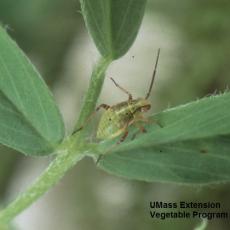The most common species of Tarnished Plant Bug (TPB) in eastern US is Lygus lineolaris. Adults are about 1/4 inch long, brown or tan or greenish with darker markings on their wings and back. Nymphs are bright green and progress through 5 molts (instars) from first hatch to the adult stage. The nymphs are sometimes mistaken for aphids. however TPB nymphs have black spots, move much faster than aphids when disturbed and lack characteristic cornicles seen on most aphids.
The tarnished plant bug is a very general feeder, attacking many kinds of trees and herbaceous plants. It feeds on many flowers including dahlia, aster, calendula, chrysanthemum, cosmos, gladiolus, poppy, salvia, daisy, sunflower, verbena, zinnia, and others. It has piercing-sucking mouth parts as do all the true bugs. The long sucking mouthpart is inserted into the plant tissues and introduces toxic saliva into the plant as it feeds. The toxin kills cells near the feeding site causing the distortion of the growth surrounding their "sting marks", yellow or brown spots or wilting of new growth. The heaviest injury often occurs during mid to late summer and is most evident during hot, dry weather, especially adjacent to recently cut hay fields. The first few generations develop on preferred hosts such as small grains, alfalfa, wild grasses, vetch, dock, and fleabane. As hay is cut or as other plants dry out, tarnished plant bugs migrate in large numbers to succulent hosts, which may be your cut flowers or garden mums.
Photo of Nymph from fact sheet: Tarnished Plant Bug, UMass Extension Vegetable Program
Fact Sheet: Field Grown Cut Flowers: Tarnished Plant Bug

